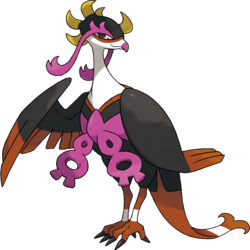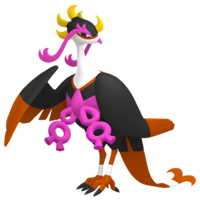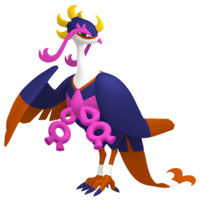Fezandipiti (Japanese: キチキギス Kichikigisu) is a dual-type Poison/Fairy Legendary Pokémon introduced during Generation IX, in The Teal Mask.
It is not known to evolve into or from any other Pokémon.
It is a member of Pecharunt's Loyal Three, along with Okidogi and Munkidori, and is associated with Ogerpon.
Biology

Fezandipiti releasing its pheromones
Fezandipiti is an avian Pokémon with a small head, a short beak with a magenta tip, and a long neck and legs. Its plumage is primarily black, with white on its head and neck, and bronze accents on its face, collar, and wing tips. It stands atop a pair of long slender bronze-colored legs having three-toed feet with sharp claws, and its tail consists of a long train of bronze-colored feathers ending in forked tips that gently curl outwards. A single white stripe accents each of its legs and tail. A crest of black feathers resembling a cap sits atop Fezandipiti's head, with golden feathers sticking out resembling a royal crown. A pair of magenta plumes also sits just above each of Fezandipiti's eyes like eyebrows and extend like long streamers with forked ends. Hanging from Fezandipiti's chest is a pair of magenta Toxic Chains, protruding from a shawl-like feature that wraps its body. Fezandipiti is a male-only species with no female counterpart.
In myth, it is said that Fezandipiti was once a Pokémon with short, dull feathers, but a wish to be beautiful led it meet the Mythical Pokémon Pecharunt, in need of retainers in its journey to Kitakami, used its Binding Mochi and Toxic Chain to tame and transform Fezandipiti. This resulted in the Toxic Chain being wrapped around its waist, chaining Fezandipiti to Pecharunt's will.[1] Fezandipiti transformed, enhancing its capabilities and giving it beautiful looks and a lovely voice. It possesses powerful pheromones, capable of captivating both humans and Pokémon with a beat of its glossy wings to scatter them through the air. It traveled from a distant land with Munkidori, Okidogi, and Pecharunt to steal the masks of Ogerpon and its partner and gift them to Pecharunt's caretakers, Okidogi and Fezandipiti were sent to sneak into Ogerpon's cave while the two were away, managing to steal three of them, but Ogerpon's partner return in time to see what was happening and fend them off, managing to protect one of the masks, though left heavily injured. After finding out, Ogerpon encounters the four close to Mossui Town, and attacks them, Fezandipiti losing its life in the fight along with the other retainers. Pecharunt managed to survive, being knocked out and sent rolling away inside its shell. To the villagers of Mossui Town, it looked like the trio had fallen protecting the village from the enraged ogre, nicknaming them the Loyal Three and giving them a proper burial while Ogerpon retreated to Oni Mountain.
Fezandipiti, together with Okidogi and Munkidori, are known as the Loyal Three, the heroes of Kitakami. The three are beloved by the people of Kitakami as heroes that once protected the land from the "evil ogre",[2] and stone statues bearing their likenesses were made by the people as an expression of their gratitude right where the three had been buried.[3] According to locals, worshiping Fezandipiti leads to both good luck and serendipitous things happening. Even with its greedy and arrogant personality, Fezandipiti has great relationships with its teammates, talking to each other in private and acting together to defeat their opponents. By consuming the Kitakami Mochis, Fezandipiti can become a Titanic Pokémon.
The Loyalty Plaza after being rebuilt.png
As seen on the signs around Kitakami
Game data
NPC appearances
- Pokémon Scarlet and Violet: The Teal Mask: Fezandipiti is a main character and a boss in the DLC.
- In The Teal Mask, Fezandipiti, Okidogi and Munkidori are resurrected by Kieran and retrieve the three masks they stole in the past, but they're scared off by the player, Carmine and Kieran, deciding to split up across Kitakami. Fezandipiti can be found at Oni Mountain with the Hearthflame Mask. Eventually the player and Carmine find it as The Titanic Fezandipiti, having grown larger thanks to the Kitakami Mochi served to the three at Kitakami Hall, but is still defeated and flees, leaving the mask behind as the team retrieves it.
- After finishing the story, the player can find Fezandipiti where it was last fought, battle it and catch it.
- In Mochi Mayhem, if Fezandipiti is used during the battle against Pecharunt, it'll become shocked and angered that it serves the player instead of itself now.

|
Spoilers end here.
|

|
Pokédex entries
| This Pokémon was unavailable prior to Generation IX.
|
| Generation IX
|
|
Paldea
#—
|
|
Kitakami
#199
|
|
Blueberry
#—
|
| Scarlet
|
Fezandipiti owes its beautiful looks and lovely voice to the toxic stimulants emanating from the chain wrapped around its body.
|
| Violet
|
Fezandipiti beats its glossy wings to scatter pheromones that captivate people and Pokémon.
|
|
|
Game locations
| This Pokémon was unavailable prior to Generation IX.
|
|
|
In side games
Held items
Stats
Base stats
| Stat
|
Range
|
| At Lv. 50
|
At Lv. 100
|
88
|
|
148 - 195
|
286 - 380
|
91
|
|
86 - 157
|
168 - 309
|
82
|
|
78 - 147
|
152 - 289
|
70
|
|
67 - 134
|
130 - 262
|
125
|
|
117 - 194
|
229 - 383
|
99
|
|
93 - 166
|
182 - 326
|
Total: 555
|
Other Pokémon with this total
|
- Minimum stats are calculated with 0 EVs, IVs of 0, and (if applicable) a hindering nature.
- Maximum stats are calculated with 252 EVs, IVs of 31, and (if applicable) a helpful nature.
|
Type effectiveness
| Under normal battle conditions in Generation IX, this Pokémon is:
|
|
|
|
|
|
|
|
|
|
|
|
|
Learnset
|
|
|
|
- Bold indicates a move that gets STAB when used by Fezandipiti
- Italic indicates a move that gets STAB only when used by an Evolution of Fezandipiti
|
|
|
|
|
- Bold indicates a move that gets STAB when used by Fezandipiti
- Italic indicates a move that gets STAB only when used by an Evolution or an alternate form of Fezandipiti
|
|
|
|
|
- Moves marked with an asterisk (*) must be chain bred onto Fezandipiti
- Bold indicates a move that gets STAB when used by Fezandipiti
- Italic indicates a move that gets STAB only when used by an Evolution of Fezandipiti
|
Side game data
Pokémon GO
| File:GO1016.png
|
Base HP: 204
|
Base Attack: 185
|
Base Defense: 228
|
| Egg Distance: N/A km
|
Buddy Distance: 20 km
|
Evolution Requirement: N/A
|
| Fast Attacks:
|
| Charged Attacks:
|
|
|
Evolution data
Sprites
| This Pokémon was unavailable prior to Generation IX.
|
|
|
In the TCG
- Main article: Fezandipiti (TCG)
Trivia
- All of the levels it learns moves at, aside from level 1, are multiples of 8. It shares this trait with Pecharunt and the rest of the Loyal Three.
Origin
Fezandipiti may be based on the copper pheasant (山鳥 yamadori in Japanese), a pheasant endemic to Japan and chosen as the prefectural bird of Akita Prefecture of the Tōhoku region (which Kitakami draws inspiration from). Both the male and the female of the copper pheasant have a similar brown color, but the male has a brighter hue with coppery luster.
Fezandipiti's plumage resembles a kimono, its crest resembles a collection of kanzashi, and its white face is reminiscent of oshiroi. These combined with its looks being described as beautiful and its voice being described as lovely could point to geisha—female Japanese performance artists—as a possible inspiration. Given that Fezandipiti is male-only, its design may also hint at male kabuki performers who assumed the role of female characters (particularly oiran) on stage and also used oshiroi. Its crest and plumage also bears resemblance to the hoatzin, whose consumption of toxic plants and emission of malodor may in turn inspired its Poison-type.
Pecharunt and its Loyal Three of Okidogi, Munkidori, and Fezandipiti, and their relationship to Ogerpon, may reference the Japanese folktale of Momotarō. The tale relates the titular Momotarō, a boy born from inside a peach, who traveled alongside a talking dog, monkey, and pheasant to fight a band of oni (a Japanese folkloric creature commonly equated to ogres in translations). The chains binding the Loyal Three may be based on shimenawa, woven ropes used in Shinto purification rituals; on Fezandipiti, the chain resembles an obi belt used to tie a kimono, such as a knotted maruobi.
Name origin
Fezandipiti may be a combination of pheasant and serendipity (an unexpected but auspicious happening).
Kichikigisu may be a combination of 吉 kichi (fortune) and 雉子 kigisu (archaic reading of pheasant).
In other languages
| Language
|
Title
|
Meaning
|
 Japanese Japanese
|
キチキギス Kichikigisu
|
From 吉 kichi and 雉子 kigisu
|
 French French
|
Favianos
|
From faveur, avian, and φασιανός fasianós
|
 Spanish Spanish
|
Fezandipiti
|
Same as English name
|
 German German
|
Beatori
|
From beatus and 鳥 tori
|
 Italian Italian
|
Fezandipiti
|
Same as English name
|
 Korean Korean
|
기로치 Girochi
|
From 길하다 gilhada, 그렇지 geureohji, and 치 (雉) chi
|
 Mandarin Chinese Mandarin Chinese
|
吉雉雞 / 吉雉鸡 Jízhìjī
|
From 吉 jí and 雉雞 / 雉鸡 zhìjī
|
 Cantonese Chinese Cantonese Chinese
|
吉雉雞 Gātjihgāi
|
From 吉 gāt and 雉雞 jihgāi
|
|
|
|
|
|
|
|
Related articles
References
External links

|
This Pokémon article is part of Project Pokédex, a Bulbapedia project that aims to write comprehensive articles on each Pokémon species, as well as Pokémon groups and forms.
|


 For other sprites and images, please see Fezandipiti images on the Bulbagarden Archives.
For other sprites and images, please see Fezandipiti images on the Bulbagarden Archives.






